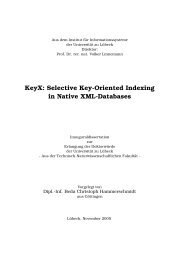Gesture-Based Interaction with Time-of-Flight Cameras
Gesture-Based Interaction with Time-of-Flight Cameras
Gesture-Based Interaction with Time-of-Flight Cameras
Create successful ePaper yourself
Turn your PDF publications into a flip-book with our unique Google optimized e-Paper software.
CHAPTER 2. TIME-OF-FLIGHT CAMERAS<br />
ventional camera. This second approach will be discussed in more detail throughout<br />
the remainder <strong>of</strong> this chapter.<br />
An important property <strong>of</strong> TOF cameras that operate <strong>with</strong> modulated illumina-<br />
tion is that they have a so-called non-ambiguity range. Beyond this range distances<br />
cannot be reconstructed unambiguously. The non-ambiguity range depends on the<br />
modulation frequency <strong>of</strong> the periodic signal. If the modulated signal passes through<br />
more than an entire period <strong>of</strong> the signal during the time the light requires to reach<br />
the object and return to the camera the distance measurement becomes ambiguous.<br />
In the case <strong>of</strong> pulsed light the problem <strong>of</strong> the non-ambiguity range can be avoided.<br />
With these cameras, one can specify a certain range interval in which the camera is<br />
to deliver range estimates. The length <strong>of</strong> the pulse and the timing <strong>of</strong> the shutter de-<br />
termine this range interval in which the amount <strong>of</strong> sensed light corresponds to the<br />
distance. A drawback is however, that this interval has to be specified beforehand,<br />
i.e. if objects in the scene are very close the camera and the shutter closes only after<br />
the entire light pulse has returned to the sensor from every object in the scene all<br />
objects appear at the same distance to the camera.<br />
As mentioned above, this chapter will give an overview <strong>of</strong> the measurement prin-<br />
ciples and properties <strong>of</strong> TOF cameras <strong>with</strong> a special focus on cameras using the ap-<br />
proach <strong>of</strong> modulated illumination. For a more detailed review <strong>of</strong> the topic refer to<br />
the work <strong>of</strong> Lange (2000).<br />
2.2 State-<strong>of</strong>-the-art TOF Sensors<br />
Over the years, a number <strong>of</strong> manufacturers <strong>of</strong>fering TOF cameras have emerged on<br />
the market. Initially, the market was mainly dominated by CSEM/MESA Imaging,<br />
PMD Technologies, Canesta, and 3DV Systems for several years. Only recently, other<br />
companies started to develop their own sensor technology or to integrate existing<br />
TOF sensors into their own cameras.<br />
A typical state-<strong>of</strong>-the-art TOF camera is the SR4000 (see Figure 2.1a), which was<br />
developed by the Centre Swisse d’Electronique et de Microtechnique (CSEM) and is<br />
manufactured and distributed by the Swiss company MESA Imaging. It is based on<br />
the phase measurement principle (Oggier et al., 2004, 2005b) and the sensor has a<br />
resolution <strong>of</strong> 176 by 144 pixels. A typical modulation frequency is 30 MHz. With this<br />
modulation frequency the camera achieves a non-ambiguity range <strong>of</strong> 5 meters. The<br />
accuracy <strong>of</strong> the range measurement is given as roughly 0.5% at a distance <strong>of</strong> 2 meters<br />
from the camera. This corresponds to an accuracy <strong>of</strong> 5 millimeters. This error is <strong>with</strong><br />
8

















